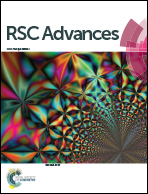High selectivity and sensitivity fluorescence sensing of melamine based on the combination of a fluorescent chemosensor and molecularly imprinted polymers†
Abstract
In this study, a sensitive and efficient approach was developed for the determination of melamine (MEL) based on the combination of molecularly imprinted polymers (MIPs) with a synthesized fluorescent chemosensor. The fluorescent chemosensor was designed ingeniously based on the open loop of a rhodamine B (RB) derivative. The MIPs were prepared by precipitation polymerization with MEL as a template, nano-CaCO3 as a porogenic agent, ethylene glycol dimethacrylate as a crosslinking agent and methacrylic acid as a functional monomer. The specific recognition ability of the MIPs was investigated by static adsorption, kinetic adsorption, and selective and competitive adsorption, respectively. The resultant materials showed an outstanding affinity and selectivity to MEL. An imprinting factor of 3.072 could be obtained. The fluorescence intensity of the chemosensor displayed an outstanding linear relationship to the concentration of MEL in the range of 6.25 × 10−4–8 × 10−2 mmol L−1. The limit of detection (LOD) was found to be 1.55 × 10−4 mmol L−1. The recovery for MEL was in the range of 86.48–89.12% for milk samples, with RSDs ranging from 3.18 to 4.91%. The proposed approach was successfully applied to determine MEL in milk samples.


 Please wait while we load your content...
Please wait while we load your content...